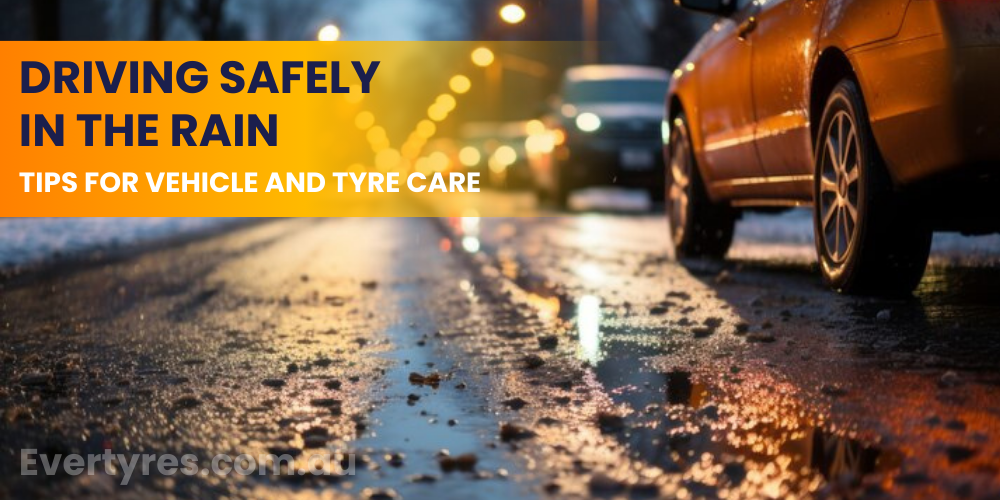Rain, a much-needed respite from the scorching sun, can transform roads into slippery hazards. But with the right knowledge and preparation, you can navigate the rain safely and confidently. These are essential tips for vehicle and tyre care, ensuring a smooth and stress-free rainy season.
Table of Contents –
1- Vehicle Preparation
Visibility
Additional checks
2- Brake system
Inspection & maintenance
Importance of Good Brakes in Wet Conditions
3- Tips for driving safely in the rain
4- Tyre Preparation tips
5- Additional care tips
6- Post drive care and checkups
7- Conclusion
8- FAQ
The pitter-patter of raindrops on your windshield might seem peaceful, but it's a call to action for drivers. Rain can significantly impact visibility, traction, and braking, making it crucial to adjust your driving behaviour and ensure your vehicle is prepared.
Vehicle Preparation:
Visibility: Replace worn-out windshield wiper blades for efficient water removal. Ensure your washer fluid reservoir is filled with good quality washer fluid for optimal visibility. Check that all lights, including headlights and taillights, are functioning properly for improved visibility and signalling in low-light conditions.
Additional Checks: Inspect your battery for any issues and ensure it's in good condition to avoid starting problems in wet weather. Look for leaks around windows and doors to prevent water damage to the interior.
Brake System
Inspection and Maintenance
A well-maintained brake system is essential for safe driving in any conditions. Before the rainy season, have your brakes inspected by a qualified mechanic. Ensure that the brake pads, rotors, and brake fluid are in good condition.
Importance of Good Brakes in Wet Conditions
Wet roads increase stopping distances, making effective brakes even more critical. Quality brakes provide better control and responsiveness, helping you navigate safely in adverse weather. Don't overlook the importance of a reliable braking system
Safe Driving Tips for Rain:
Reduce Speed: The posted speed limit is meant for ideal conditions. When driving in rain, slow down significantly to allow more time for reaction and reduce the risk of hydroplaning. A good rule of thumb is to reduce your speed by at least 10 km/h.
Increase Following Distance: Maintain a safe following distance from the vehicle ahead, at least double the usual distance. This allows for increased reaction time and prevents rear-end collisions caused by reduced traction.
Avoid Sudden Activities: Abrupt braking, acceleration, and sharp turns can cause your car to skid or hydroplane. Steer smoothly and anticipate your activity to maintain control.
Use Low Beam Headlights: Turn on your low beam headlights during rain to improve your visibility for yourself and other drivers. Avoid using high beams, as they can reflect off the wet road and impair your vision.
Be Aware of Your Surroundings: Pay close attention to the road, watch out for hazards like puddles, potholes, and debris, and anticipate the actions of other drivers. Be especially cautious when driving near trucks or buses that can create large spray clouds.
Avoid Driving through Flooded Areas: Never attempt to drive through flooded areas. The water depth can be deceiving, and your car could get stuck or swept away. Find an alternate route or wait for the floodwaters to recede.
Tyre Preparation:
Tread Depth: Your tyres are your primary contact with the wet road. Ensure they have sufficient tread depth (at least 3mm) for optimal grip. Worn-out tyres significantly increase the risk of hydroplaning, where your tyres lose contact with the road surface due to a layer of water.
Tyre Pressure: Regularly check and adjust tyre pressure according to manufacturer recommendations. Underinflated tyres can affect handling and braking performance, especially on wet roads.
Tyre Type: Consider switching to all-season or rain tyres for frequent rainy weather driving. These tyres offer better traction and handling on wet roads compared to standard tyres. At Evertyres, we are Australia's top and most trusted tyre dealer. We are proud to offer a wide range of high-quality, reliable tyres, and we are committed to educating our customers on the importance of tyre safety. Visit our website to learn more about our products and services.
Additional Tips:
Use cruise control with caution in rainy weather, as it can hinder your ability to adjust speed quickly in case of sudden changes in road conditions.
Remain calm if you encounter hydroplaning. Take your foot off the gas pedal and steer gently in the direction you want to go until you regain traction.
Allow extra travel time during rainy weather to account for slower driving speeds and possible delays.
Post-Drive Care:
After driving in the rain, it's crucial to take proper care of your vehicle:
Dry your car: Wash and dry your car thoroughly to prevent rust and corrosion. Pay special attention to areas prone to rust, like the undercarriage and wheel wells.
Check tyre pressure: Ensure your tyre pressure is still at the recommended level after the drive.
Inspect brakes: Check your brakes for any signs of wear or damage, especially if you encounter deep puddles or flooded areas.
Clean headlights and taillights: Remove any dirt or grime accumulated on your headlights and taillights to maintain optimal visibility.
Conclusion:
By following these tips and practising safe driving habits, you can navigate the rainy season safely and confidently. Remember that preparation, awareness, and responsible driving are key to ensuring a smooth and enjoyable journey. So, buckle up, stay alert, and navigate the rain with confidence!
FAQ-
1. How often should I check my tyre tread depth?
It's recommended to check your tyre tread depth at least once a month and before long trips.
2. When should I switch to all-season or rain tyres?
Consider switching to all-season or rain tyres if you frequently drive in rainy weather or live in an area with significant rainfall. These tyres offer better traction and handling on wet roads compared to standard tyres.
3. How can I avoid hydroplaning?
To reduce the risk of hydroplaning, ensure your tyres have adequate tread depth and maintain proper tyre pressure. Slow down when driving in the rain, especially when approaching puddles or standing water. Avoid sudden braking and acceleration, and make smooth steering inputs.
4. What should I do if my car battery dies in the rain?
If your car battery dies in the rain, call a roadside assistance service or a tow truck. Avoid trying to jump-start your car yourself, as this could be dangerous.
5. What's one additional tool I can use to improve my safety while driving in the rain?
A rain-repellent windshield treatment helps water bead up and roll off your windshield, improving visibility in heavy rain.
















